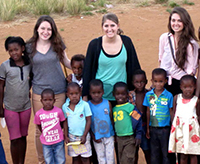The prevalence of HIV and AIDS in South Africa is an issue that continues to define the country and its citizens. It is estimated that more than six million South Africans live with HIV/AIDS. This is more cases than any other country in the world.
In spring 2013, Robert Sedlack ’89, associate professor in Notre Dame’s Department of Art, Art History, and Design, traveled with a team of 11 students to Johannesburg, South Africa to gain first-hand perspective on the problem and collaborate with South African community organizations.
“I never imagined that that was something within the scope of the University to do—to send me to South Africa to meet the people that I was trying to reach with my design projects,” says senior Maria Massa. “I got to really understand on a personal level what they need in this country and what I can actually do to make change.”
 Notre Dame design students Sara Kolettis, Laura Straccia, and Maria Massa in South Africa
Notre Dame design students Sara Kolettis, Laura Straccia, and Maria Massa in South Africa
In their research, the students found that one of the challenges facing the country is how to persuade South Africans with HIV to begin and maintain an anti-retroviral (ARV) medication regimen. In 2007, only 28 percent of those infected were receiving ARV treatment, partly due to the stigma attached to the virus and the misconception that HIV is a “death sentence.”
“The assumption once someone gets HIV is really misguided actually,” says Sedlack. “And that’s one place that design and visual communication can come into play—by sharing the fact that these people can have long and healthy lives if they continue to take their antiretroviral medicines.”
Sedlack and his students from the University’s College of Arts and Letters are responding to the challenge by designing resources that empower mothers and children with HIV/AIDS to “live positively.”
The designers have created a wide range of solutions, including an online support community for young women, a video series, and HIV-related educational materials for children, which they hope to share with teachers and community advocates.
“The social model of design that we’re teaching students and that they’re practicing is using design to inform people, to educate people, to help change opinions, to help people grow and learn and live better lives,” Sedlack says.
“And that’s how we at the University of Notre Dame see design.”


